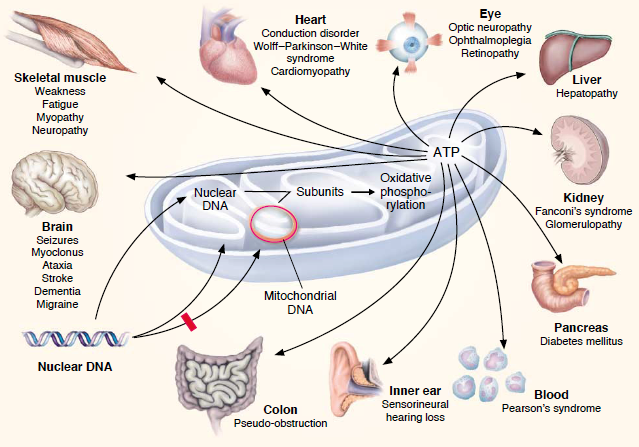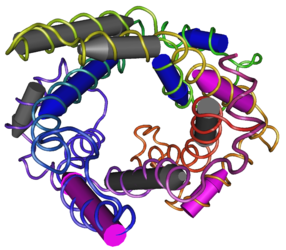Uncoupling Protein 2
From Proteopedia
(Difference between revisions)
| Line 1: | Line 1: | ||
==Uncoupling Protein 2 (UCP2) in Diabetes== | ==Uncoupling Protein 2 (UCP2) in Diabetes== | ||
<StructureSection load='2LCK' size='500' side='right' caption='Uncoupling Protein 2' scene=''> | <StructureSection load='2LCK' size='500' side='right' caption='Uncoupling Protein 2' scene=''> | ||
| - | This is a default text for your page '''Kimberly Jimenez: Uncoupling Protein 2'''. Click above on '''edit this page''' to modify. Be careful with the < and > signs. | ||
| - | You may include any references to papers as in: the use of JSmol in Proteopedia <ref>DOI 10.1002/ijch.201300024</ref> or to the article describing Jmol <ref>PMID:21638687</ref> to the rescue. | ||
| - | [[Image:286px-MMDB_ID_92271_PDB_ID_2LCK_Mitochondrial_Uncoupling_Protein_2.png]] | ||
| - | |||
| - | Figure 1: Uncoupling Protein 2 | ||
== Introduction == | == Introduction == | ||
Mutations involving the mitochondria can lead to varies diseases. One particular disease that involves a 3243G mutation in the mitochondrial DNA-encoded tRNA gene is known as Diabetes Mellitus (DM). The predominant issues seen in patients with this disease is glucose intolerances due to gradual development of pancreatic beta-cell malfunction which can be seen with increased age. Uncoupling proteins are key factors that generates these issues. Low levels of uncoupling proteins (UCPs) can lead to high mitochondrial membrane potentials. These increased potentials favor generation of reactive oxygen species (ROS). Increased ROS levels assist the progress of apoptosis and the differentiation state of pancreatic beta-cells which ultimately lead to inadequate secretion of insulin and an inability to maintain glucose levels. Five UCPs have been discovered in mammals, but UCP1, UCP2 and UCP3 have the biggest roles in DM. UPC1’s underlying determinant of DM is from an imbalance of energy intake and expenditure. Research has also found that polymorphisms and UCP1’s mRNA expressions are highly associated with DM. UCP2, the main focus of this research, is known as a negative regulator of insulin secretion and plays the biggest role in DM generation. The ROS initiate UCP2 which is preceded by decreased beta-cell ATP synthesis and lack of regulation of glucose-stimulating insulin secretion. Polymorphism of UCP2 gene is also correlated with DM. UCP3 is also shown to influence insulin secretion through these beta-cells, but less research has been conducted on these proteins. | Mutations involving the mitochondria can lead to varies diseases. One particular disease that involves a 3243G mutation in the mitochondrial DNA-encoded tRNA gene is known as Diabetes Mellitus (DM). The predominant issues seen in patients with this disease is glucose intolerances due to gradual development of pancreatic beta-cell malfunction which can be seen with increased age. Uncoupling proteins are key factors that generates these issues. Low levels of uncoupling proteins (UCPs) can lead to high mitochondrial membrane potentials. These increased potentials favor generation of reactive oxygen species (ROS). Increased ROS levels assist the progress of apoptosis and the differentiation state of pancreatic beta-cells which ultimately lead to inadequate secretion of insulin and an inability to maintain glucose levels. Five UCPs have been discovered in mammals, but UCP1, UCP2 and UCP3 have the biggest roles in DM. UPC1’s underlying determinant of DM is from an imbalance of energy intake and expenditure. Research has also found that polymorphisms and UCP1’s mRNA expressions are highly associated with DM. UCP2, the main focus of this research, is known as a negative regulator of insulin secretion and plays the biggest role in DM generation. The ROS initiate UCP2 which is preceded by decreased beta-cell ATP synthesis and lack of regulation of glucose-stimulating insulin secretion. Polymorphism of UCP2 gene is also correlated with DM. UCP3 is also shown to influence insulin secretion through these beta-cells, but less research has been conducted on these proteins. | ||
| + | |||
| + | == History == | ||
| + | In 1963, researchers discovered that mitochondria have their own DNA or "blueprint" (mtDNA), which is different than the nuclear DNA (nDNA) found in the cells' nucleus. <ref>Mitochondrial Disorder Medical Information. http://www.mitoaction.org/medical-information.</ref> Later, in 1988, mutations of this mitochondria DNA was discovered. Mutations like deletions and point mutations were found in all the mitochondrial disorders.<ref>Luft, R.; Luthman, H. Physiopathology of mitochondria. From Luft's disease to aging and diabetes. https://www.ncbi.nlm.nih.gov/pubmed/8366714.</ref> | ||
== Disease == | == Disease == | ||
| Line 22: | Line 20: | ||
| - | The disorder which affects the pancreas is caused by the A3243G mutation which causes diabetes. Bilateral hearing impairment is a symptom carried by the carrier of mitochondrial diabetes. Some other symptoms that can be seen is a change in pigmentation of the retina. <ref>Maassen, J. A.; Leen; Hart; Essen, E. van; Heine, R. J.; Nijpels, G.; Tafrechi, R. S. J.; Raap, A. K.; Janssen, G. M. C.; Lemkes, H. H. P. J. Mitochondrial Diabetes. http://diabetes.diabetesjournals.org/content/53/suppl_1/S103 | + | The disorder which affects the pancreas is caused by the A3243G mutation which causes diabetes. Bilateral hearing impairment is a symptom carried by the carrier of mitochondrial diabetes. Some other symptoms that can be seen is a change in pigmentation of the retina. <ref>Maassen, J. A.; Leen; Hart; Essen, E. van; Heine, R. J.; Nijpels, G.; Tafrechi, R. S. J.; Raap, A. K.; Janssen, G. M. C.; Lemkes, H. H. P. J. Mitochondrial Diabetes. http://diabetes.diabetesjournals.org/content/53/suppl_1/S103.</ref> This mutation can be seen around the age of 38 years old, this disease is age dependent in the fact that over time there is a deterioration of glucose homeostasis. The pattern of inhertitance of this disorder depends on the mitochondria of the mother and can be passed down to both male and female offspring. |
== Function == | == Function == | ||
| + | [[Image:286px-MMDB_ID_92271_PDB_ID_2LCK_Mitochondrial_Uncoupling_Protein_2.png]] | ||
| + | Figure 2: Uncoupling Protein 2 | ||
This is a sample scene created with SAT to <scene name="/12/3456/Sample/1">color</scene> by Group, and another to make <scene name="/12/3456/Sample/2">a transparent representation</scene> of the protein. You can make your own scenes on SAT starting from scratch or loading and editing one of these sample scenes. | This is a sample scene created with SAT to <scene name="/12/3456/Sample/1">color</scene> by Group, and another to make <scene name="/12/3456/Sample/2">a transparent representation</scene> of the protein. You can make your own scenes on SAT starting from scratch or loading and editing one of these sample scenes. | ||
Revision as of 03:11, 15 April 2019
Uncoupling Protein 2 (UCP2) in Diabetes
| |||||||||||
References
- ↑ Mitochondrial Disorder Medical Information. http://www.mitoaction.org/medical-information.
- ↑ Luft, R.; Luthman, H. Physiopathology of mitochondria. From Luft's disease to aging and diabetes. https://www.ncbi.nlm.nih.gov/pubmed/8366714.
- ↑ Maassen, J. A.; Leen; Hart; Essen, E. van; Heine, R. J.; Nijpels, G.; Tafrechi, R. S. J.; Raap, A. K.; Janssen, G. M. C.; Lemkes, H. H. P. J. Mitochondrial Diabetes. http://diabetes.diabetesjournals.org/content/53/suppl_1/S103.


